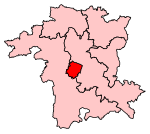Worcester Shrub Hill railway station
1850 establishments in EnglandBuildings and structures in Worcester, EnglandFormer Great Western Railway stationsFormer Midland Railway stationsGrade II* listed buildings in Worcestershire ... and 8 more
Grade II* listed railway stationsPages with no open date in Infobox stationRailway stations in Great Britain opened in 1850Railway stations in WorcestershireRailway stations served by Great Western RailwayRailway stations served by West Midlands TrainsTransport in Worcester, EnglandUse British English from March 2015

Worcester Shrub Hill railway station is one of two railway stations serving the city of Worcester in Worcestershire, England. It is managed by West Midlands Trains, operating here under the West Midlands Railway brand, and it is also served by Great Western Railway. The platform 2B waiting room of Worcester Shrub Hill is Grade II* listed and reopened in 2015 after a ten-year refurbishment project. The city's other station, Worcester Foregate Street, is situated in the city centre; Shrub Hill is situated to the east. A third station Worcestershire Parkway is located just outside the city to the south-east.
Excerpt from the Wikipedia article Worcester Shrub Hill railway station (License: CC BY-SA 3.0, Authors, Images).Worcester Shrub Hill railway station
Shrub Hill, Worcester, England Red Hill
Geographical coordinates (GPS) Address External links Nearby Places Show on map
Geographical coordinates (GPS)
| Latitude | Longitude |
|---|---|
| N 52.195 ° | E -2.209 ° |
Address
Worcester Shrub Hill
Shrub Hill
WR4 9EJ Worcester, England, Red Hill
England, United Kingdom
Open on Google Maps










